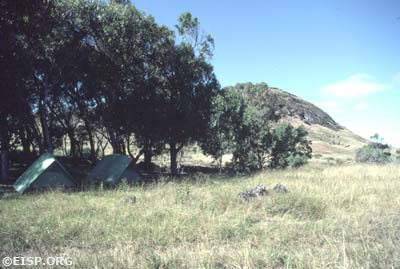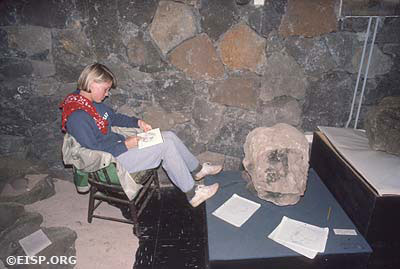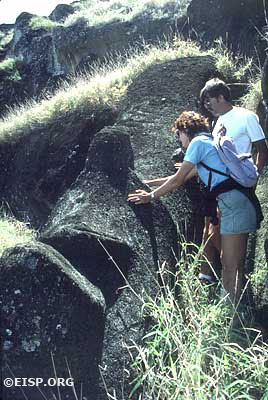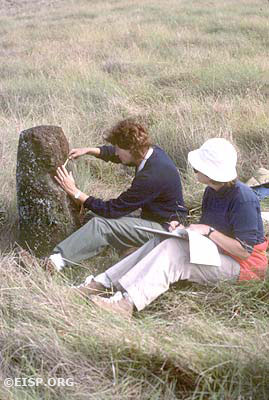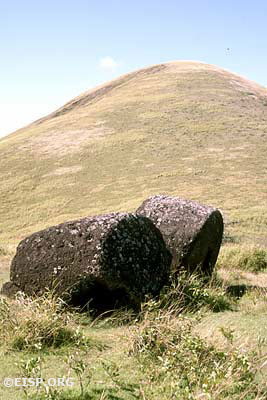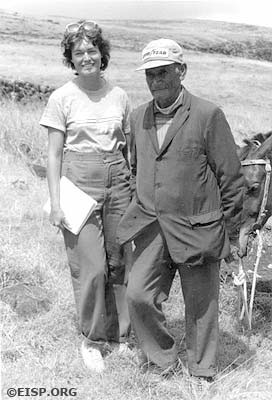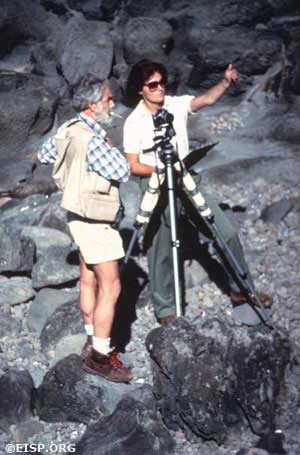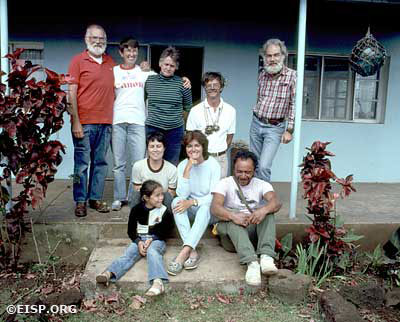Easter Island Statue Project History: 1984
Goals and Methods
The combined fieldwork of the 1982 and 1983 field seasons described approximately 300 statues and mapped seven major ahu sites. All of the surveyed and mapped quadrangles were included in the study area, and most were exhaustively examined. Data were sampled from selected unmapped areas of the island.
As the third season of the Easter Island Statue Project began, our data analysis clearly showed that:
- Morphological and stylistic attributes can be defined metrically and illustrated graphically. They sufficiently describe statue shape variation.
- There are four general geographic loci in which statues are found. These loci may be further divided into sub-areas.
- There are three types of human form carvings in archaeological contexts: monumental, portable and bas-relief.
- Positions (4) of sculpture and types (5) of materials are defined.
- Positioning and proportions of design details are generally nearly symmetrical. Therefore, some measurements taken on the axis can be recorded.
- Statues in the quarry uniformly lack eye sockets, while statues with rounded eye sockets are located in proximity to ahu.
- Pukao, referred to by early observers as “topknot” or “hat” are found in the quarry in which they were carved (Puna Pau) or are almost always associated with ahu (there are only two exceptions). They do not occur in Rano Raraku.
- The largest number of statues in the total corpus is located in the south coastal zone.
Some of these observations have long been superficially evident. Others have been noted in the early surveying and cataloging work of such pioneers as Paymaster Thomson of U.S.S. Mohican, Katherine Routledge, co-leader of the Mana Expedition to Easter Island, 1914, and Father Sebastián Englert. Importantly, however, the EISP has validated them with empirical evidence.
Research hypotheses that have evolved out of the study to date are:
- Statue style will relate to ahu construction type.
- Statue style sequence will relate to ahu chronology.
- The greatest number of statues will be located in relation to the largest and most important lineage centers. Pukao will be associated with these statues.
- Within specific lineage centers it will be possible to relate statue type with ahu phase, establishing a chronological sequence.
- Design details of discrete stylistic attributes are capable of description and type categorization.
- Design details will relate to status and lineage division.
- Clustering of statue type within a given area will relate to political division.
In the Field
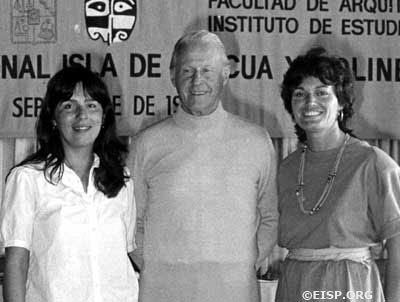
Jo Anne Van Tilburg (right), with Thor Heyerdahl, and Patricia Vargas Casanova at the Premier Congreso Isla de Pascua y Polinesia Oriental. ©1984 EISP/JVT/ Photo: D. C. Ochsner.
We rented the same vehicle and house in Hanga Roa that we had during 1983, and settled in for three months. During this period the landmark “Premier Congreso Internacional Isla de Pascua y Polinesia Oriental” took place from September 6 to 12, thus interrupting—and enriching—our work. Our seven-member crew was enhanced again by the presence of Felipe Teao A. and we were really privileged to work on the north coast with Jose Fati, another distinguished elder. We documented thirty new sites and added fifty-two intact moai to the existing inventory. Some forty-seven torso and head segments, and 30 additional fragments, accounted for an additional forty-five statues.
We camped in the vicinity of Rano Raraku, which was a truly memorable experience. I was reminded often of The Mystery of Easter Island and Katherine Routledge’s poetic description of her nights in Camp Hotu Iti.
Immediately above the camp towered the majestic cliff of Raraku, near at hand were its mysterious quarries and still erect statues…The scene was most wonderful of all when the full moon made a track of light over the sea…the white beams turned the waving grass into shimmering silver and lit up every crevice in the mountain above.
We selected 17 statues at random, documenting them fully in order to make a comparative analysis of the accuracy of our measurements relative to those taken by Lilian González N. of the Centro de Estudios team. A pleasingly compatible margin of error was evident (about 5 cm on the average).
When Ann Lockie and her daughter Lynn joined us as volunteers, Lynn took on the primary job of sketching objects and artifacts in the Hanga Roa museum (now Museo Antropológico Padre Sebastián Englert). She especially sought out fragments of statues not carved in Rano Raraku. Although we didn’t know it then, Lynn’s early work was the beginning of a museum inventory that would grow into a large and comprehensive project in museums all over the world.
One of our main interests was the new statues we were finding that were not carved of Rano Raraku tuff. Dr. Steve Williams, the geologist on our team, was also intrigued, and investigated many source areas for lithic materials. The Puna Pau quarry has long been recognized as the source of red scoria used in making pukao, and obsidian from Orito quarries is distinct in quality from that taken from Moto Nui. Basalt used in the construction of lineage ahu has always been assumed to be local (that is, from quarries near each structure).
We described nine noteworthy red scoria statues in quadrant 18, all of them small, none associated with ahu and none apparently carved from Puna Pau scoria. These statues and others, and the red scoria of which they were carved, took on new significance when we made a startling discovery in the vicinity of Vai Mata, close to a prone statue and in front of the ahu. The deep grass that usually covered the area had burned off, exposing a foundation built of assorted stone in an oval shape. José Fati and Alberto Ika, neither of whom had ever seen such a structure before, were puzzled but thought it was a hare oka, or round house foundation.
The most distinctive feature of the overall oval shape was what appeared to be a red scoria pukao incorporated into it and placed flush with the ground. A shallow basin, complete with a deeply incised channel leading into it, had been cut into the pukao. The somewhat haphazard assemblage of apparently scavenged stone suggested that the structure was later than others in the vicinity, and that the stone had been reused from them. The overall impression was of a possible burial, and the presence of red scoria strengthened that suggestion (red scoria is frequently scattered on burials, and some pukao at large ahu sites mark graves). We mapped the site.
Findings
Within days of our discovery at Vai Mata, the Centro de Estudios team excavated the odd structure and found an extended burial. The obvious use of red scoria confirmed our hypothesis that the material, like the tuff of Rano Raraku, had its own ceremonial and symbolic value.
During the course of fieldwork since 1982, we had noticed that red scoria (conspicuously different in color from basalt) had been placed in the corners of the seaward walls of ten ahu. In 1984 we collected samples from four sites and Steve Williams analyzed them using the EDS method. Results suggest that these worked blocks may have been quarried from some source outside the immediate area of the specific ahu. Further, a fragment from one moai carved of red scoria is not similar to either quarry samples or samples taken from an oxidized scoria outcrop near the platform. This suggests that material for both statues and ahu building blocks may not always have been locally obtained.
Our cumulative documentation clearly points to the fact that red scoria is directly related to ritual activity. The rituals, none of which took place on ahu (although some were related to ahu) were probably related to death and burial. The red scoria pukao placed on the heads of about 100 statues on ahu, therefore, can reasonably be presumed to relate to mortuary practices or practitioners.
Want to know more?
Van Tilburg, J. 1984. “Easter Island statuary: The moai documentation project 1984 field season. Copy on file with the UCLA Rock Art Archive and the Centro de Estudios, Universidad de Chile.
Van Tilburg, J. 1986b. “Red scoria on Easter Island: Sculpture, artifacts, and architecture.” Journal of New World Archaeology 1 (7) 1-27.
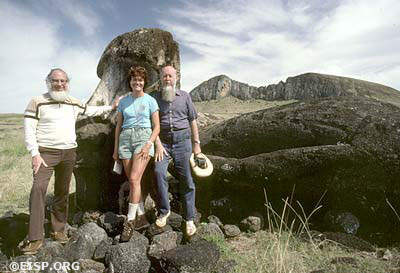
Dr. Roger Green, Jo Anne Van Tilburg and Bengt Danielsson, at Tongariki prior to restoration, 1984. ©1984 EISP/JVT/ Photo: D. C. Ochsner.
 English
English  Español
Español 